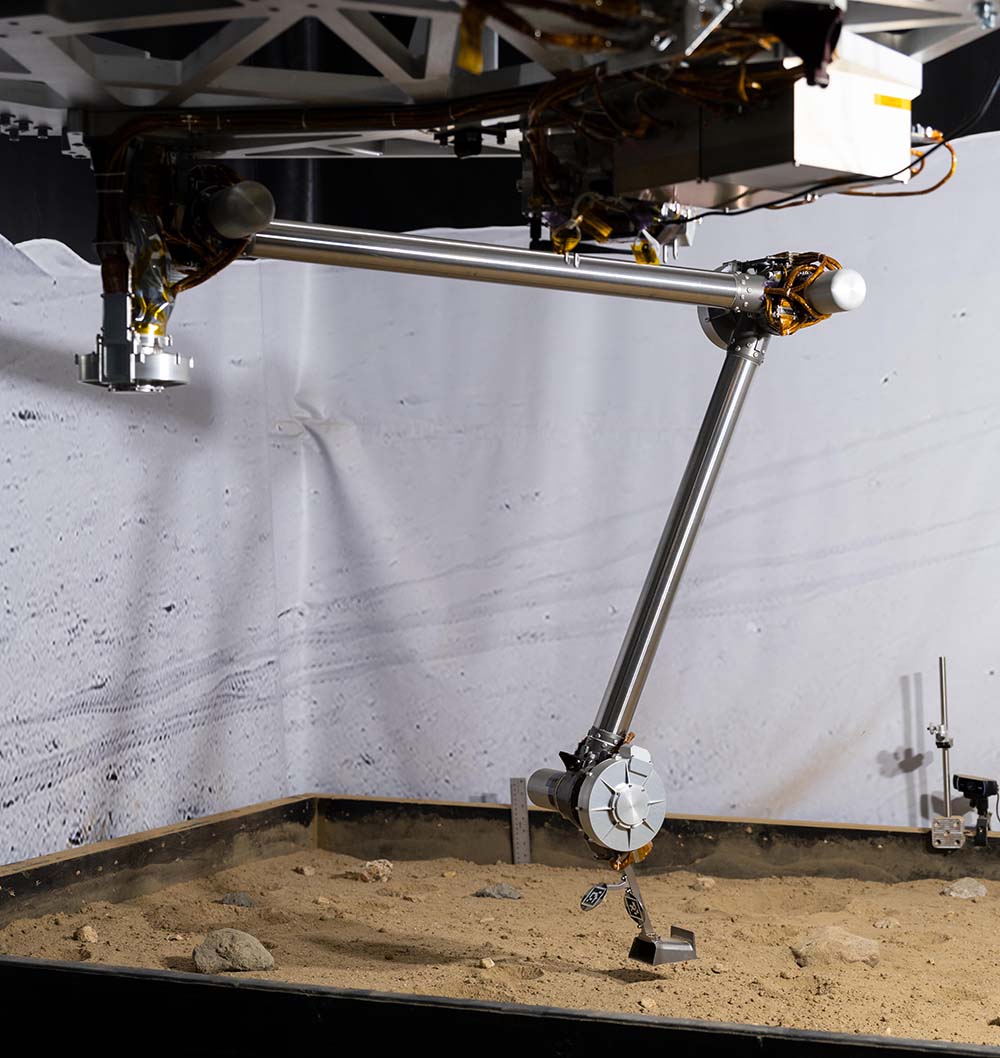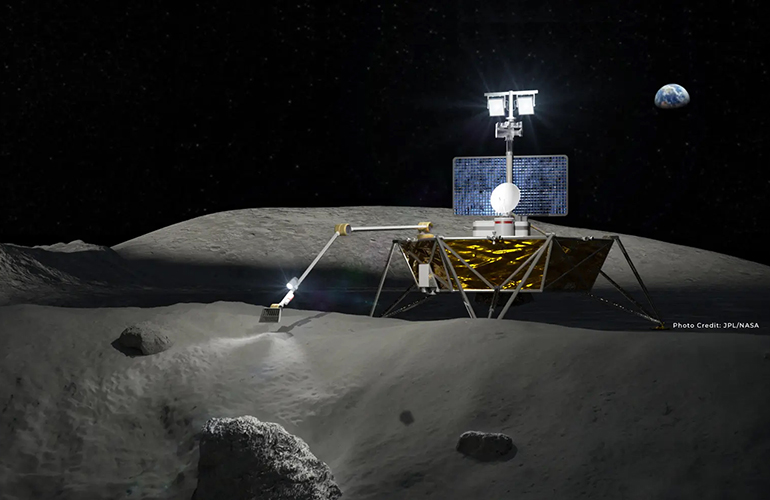|
Listen to this article  |

COLDArm, developed by NASA and Motiv Space Systems, can operate at temperatures as low as -280º F (-173° C). | Source: NASA/JPL-Caltech
Covered in deep craters and surrounded by steep mountains, the Lunar south pole offers a range of extreme and volatile conditions. Here, the sun hovers just below or above the horizon. When it sits below the horizon, creating a Lunar night that lasts for up to 14 Earth days, temperatures can drop to -267º F (-166° C), and when the sun is shining above the horizon, temperatures climb up to 130º F (54° C).
But even when the sun is heating the Moon’s south pole, permanently shadowed regions, such as in craters and in the shadows of its mountains that reach heights of over 9 km, haven’t seen any sunlight in billions of years. These areas can drop to temperatures as low as -334º F (-203° C). These shadowed regions act as traps to some of the Moon’s most volatile materials, such as water that would evaporate at the moon’s highest temperatures but remain frozen for billions of years in these crucial spots.
Because of its extreme conditions, the Moon’s south pole has remained largely unexplored by space crews and with instruments sent to the moon. Typical spacecraft that rely on energy-consuming heaters aren’t able to stay warm in the extreme cold, making it nearly impossible for scientists to study these areas.
NASA hopes to have a chance to explore these areas on its Artemis mission, a three-part mission that eventually aims to put a crew of astronauts on and around the Moon. The first part of the mission, which launched on November 16, 2022, aims to test NASA’s Space Launch System and its Orion spacecraft around the Moon.
“It’s a mission that’s a precursor to future astronaut missions and will also be a precursor to future robotic missions because eventually there will be the delivery of robotic systems,” Motiv Space Systems‘ Vice President of Business Development Tom McCarthy said.
The second part of the mission, which aims to send a crew of astronauts farther into the solar system than humanity has ever been before, will be launching from NASA’s Kennedy Space Center in Florida in 2023. The third phase will launch in 2024.
A robotic arm that goes beyond

An illustration of COLDArm on a lander on the moon. | Source: NASA/JPL-Caltech
To access these crucial and frigid areas of the moon during the Artemis missions, NASA has been working with Motiv Space Systems to develop a robotic arm capable of operating in these areas. The Cold Operable Lunar Deployable Arm (COLDArm) robotic arm system can function in temperatures as low as -280º F (-173° C) without needing an internal heating system that can use up to 30% of a mission’s daily energy budget.
“COLDArm is a recent technology development. So, we’re partnered with JPL, and each of us brought technologies that have been developed for cryogenic operation,” McCarthy said. “JPL, in particular, had some actuation capabilities and Motiv had developed avionics that work to -292°F (-180º C).”
Motiv Space Systems isn’t a stranger to developing complicated robotic technology that needs to operate in extreme conditions. The company helped to develop that robotic arm on the Perseverance Rover, which is currently helping the rover collect rock samples from Mars. COLDArm, however, will have to make it through even colder conditions than Perseverance faces during Martian nights.
“I think the primary difference is that with COLDArm, we have to be a little more flexible,” McCarthy said. “So with the Mars 2020 arm, we had some really nice analogs because we know that environment very well. The rover has a lot of history and experience built into the design of the rover and the robotic arm and what it takes to have that operate successfully on Mars.”
McCarthy said with COLDArm, Motiv wasn’t even sure which lander it would be working with when it does go into space, so the company had to make the arm as flexible, and modular, as possible.
The COLDArm that NASA has been working with measures 2m long and is equipped with two commercially available cameras, the same ones the Inenguity helicopter uses on Mars, that it will use for 3D mapping. The robotic arm uses gears made of bulk metallic glass, a solid metallic material with a unique composition and structure. This structure makes it tougher than ceramic, two times as strong as steel and gives it better elastic properties than either material. The arm also has a 6-axis force torque sensor embedded in its wrist, allowing it to feel what it’s doing in all directions.
“There are certain families of electronics that work at cold temperatures,” McCarthy said. “Even though data sheets only say things to -55º F (-48° C), that’s kind of where the standard stops testing. But there are families of parts, and there are plenty of electrical solutions out there, that still work at cryogenic temperatures.”
According to McCarthy, getting COLDArm to operate at cryogenic temperatures took a combination of research, testing, validation and an understanding of how mechanical components change when the temperature changes.
COLDArm borrows a few more pieces of technology from Ingenuity, the helicopter currently exploring Mars with the Perseverance Rover. These include a processor, similar to ones used in consumer smartphones, and open-source flight software, called F Prime, developed by JPL. NASA hopes that, like Ingenuity, COLDArm will be able to perform tasks without real-time input from mission controllers on Earth.
While COLDArm was developed for the Artemis missions, Motiv Space Systems hopes that the robotic arm could be used as a general-purpose instrument in future space missions because of its flexibility with end-effectors.
“I think there’s a lot to be gained from the technologies that are embedded in COLDArm,” McCarthy said. “I think it can take some slightly different shapes or forms, but the technologies themselves, between the approaches of modularity, the actuation and avionic developments and the extreme environment survivability, those things will be critical for lots of systems.”
Before it can be sent anywhere in space, however, COLDArm still has some hoops to jump through on Earth.
“[COLDArm] is going through a system-level test now. Early next year, we should be in our full-system, thermal environment testing, where we test everything out at cryogenic temperatures. That’s what we’ve been doing at component levels already and had success there,” McCarthy said. “So we’re getting prepared for full system-level validation and qualification at these extreme temperature regimes.”
Credit: Source link


Comments are closed.